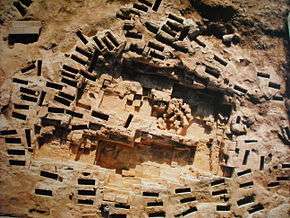Tuvixeddu necropolis
| Necropoli di Tuvixeddu | |
 | |
 Shown within Italy | |
| Location | Cagliari, Sardinia, Italy |
|---|---|
| Region | Sardinia |
| Coordinates | 39°13′44″N 9°6′04″E / 39.22889°N 9.10111°ECoordinates: 39°13′44″N 9°6′04″E / 39.22889°N 9.10111°E |
| Type | Necropolis |
| History | |
| Founded | 6th century BC |
| Cultures | Punic, Roman |
| Site notes | |
| Management | Soprintendenza per i Beni Archeologici per le province di Cagliari e Oristano |
| Public access | Yes |
The necropolis of Tuvixeddu is a punic necropolis, one of the largest in the Mediterranean, located in a hill inside the city of Cagliari, Sardinia, called Tuvixeddu (in sardinian language Tuvixeddu mean hill of the little holes).
Between the 6th and 3rd centuries BC the Carthaginians chose this hill to bury their dead: these burials were reached through a well dug into the limestone rock (from two to eleven meters deep), a small opening introduced to the burial chamber. The burial chambers were beautifully decorated; there were found amphorae and ampoules for the essences. Of particular interest among the Punic tombs, the "Uraeus tomb" and the "Fighter Tomb", decorated with paintings of palm trees and masks, still well preserved. Another famous tomb is that "of the Wheel".
On the slopes of the Tuvixeddu hill there is a Roman necropolis, which overlooked the road at the exit of the city. The Roman necropolis consists mainly of arcosolium tombs and columbaria.
The necropolis opened to the public in May 2014, during the XVIII edition of "Monumenti Aperti". The archaeological area is large, it originally consisted of an area of about 80 hectares (200 acres).
Gallery
-

Reconstruction of a punic tomb of Tuvixeddu
-

Decoration of the Ureaus tomb
-
.jpg)
Roman tomb
-

View of the hill of Tuvixeddu (center)
Sources
- Tuvixeddu - Un colle da salvare - Dossier a cura del circolo di Cagliari della Legambiente, 1993.
- Cagliari, la città sotterranea: grotte, cisterne, necropoli e cavità segrete". Edizioni Sole, a cura di Marcello Polastri, Cagliari 2001.
- Tuvixeddu. La necropoli occidentale di Karales, Della Torre, Cagliari 2000, ISBN 88-7343-323-5.
- Tuvixeddu. Tomba su tomba, Sovrintendenza Archeologica per le province di Cagliari e Oristano, Cagliari 1998.
- Tuvixeddu vive", Roberto Copparoni,Angelo Pili,Marcello Polastri Artigianarte, I edizione 1997 e ristampa nel 2013 Cagliari, IT\ICCU\CAG\0029495.
- Carta turistica di Tuvixeddu", a cura di Roberto Copparoni con testi tradotti in inglese da Annalisa Pirastu, Edita da Associazione di volontariato Amici di Sardegna Cagliari giugno 2014
External links
- Lo speciale Tuvixeddu sul sito della Regione Autonoma della Sardegna(Italian)
- La Grotta della Vipera su SardegnaMappe(Italian)
- Portale sulle esplorazioni sotterranee a Tuvixeddu(Italian)
